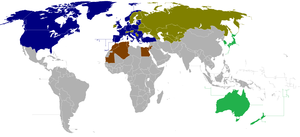Mediterranean Dialogue
The Mediterranean Dialogue, first launched in 1994, is a forum of cooperation between NATO and seven countries of the Mediterranean. Its stated aim is "to create good relations and better mutual understanding and confidence throughout the region, promoting regional security and stability and explaining NATO's policies and goals."[1]
The Dialogue reflects NATO's view that security in Europe is tied to the security and stability in the Mediterranean. It also reinforces and complements the Euro-Mediterranean Partnership and the Organization for Security and Co-operation in Europe's Mediterranean Initiative.
Members

The Mediterranean Dialogue initially started with five countries but has added two more over time.
Individual Cooperation Programme (ICP)
On October 16, 2006, NATO and Israel finalized the first ever Individual Cooperation Programme (ICP)[3] under the enhanced Mediterranean Dialogue, where Israel will be contributing to the NATO maritime Operation Active Endeavour. The ICP covers many areas of common interest, such as the fight against terrorism and joint military exercises in the Mediterranean Sea.[4] More ICP agreements were signed with Egypt (2007) and Jordan (2009), and NATO expects further agreements to be signed with additional Mediterranean Dialogue member states in the future.
See also
References
- NATO Topics: NATO's Mediterranean Dialogue - Linking regions together Archived 2009-09-11 at the Wayback Machine
- "Chicago Summit Declaration; Issued by the Heads of State and Government participating in the meeting of the North Atlantic Council in Chicago on 20 May 2012". nato.int. NATO. 20 May 2012. Retrieved 3 September 2016.
- "NATO Press Release (2006) 123 - 16 Oct. 2006".
- Israel moves closer to NATO missions